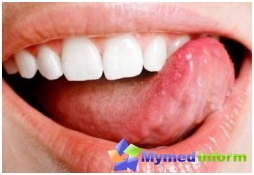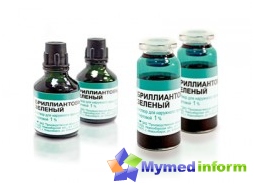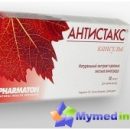Yazens in the language are erosive foci of inflammation of the mucous membrane, which are accompanied by itching or painful sensations. The reasons for which this defect arises, a lot. The mucosa of our main organ speech can be subjected to the devastating effects of external factors, as well as to respond in this way on the diseases of the oral cavity or other somatic diseases of the body. Our site proposes to consider the main factors that may otherwise affect the state of the oral cavity as a whole and the health of the language in particular.
The reasons for the ulceration of the surface of the language

To determine the character and sequence of treatment, you need to establish a reliable reason that underlies this unpleasant condition. So, the factors provoking point inflammation of the mucous membrane of the language is customary to divide on 3 large groups. Read with each of them in order.
Diseases of oral cavity.
- Aphtose Stomatitis. In most cases, this disease acquires a chronic shape and its course stretches for months, and then years. All this time, the periods of exacerbation alternate with the periods of remission. The fruit of the disease becomes the so-called AFTs - small ulcerations in the oral cavity and in the language. On the mucosa, both one ulcer and their accumulation can be formed. Despite their modest sizes, the AFTs are extremely painful, so it is impossible to ignore the problem. The disease reminds of itself whenever the patient takes food or talks. With appropriate treatment, the aftose ulcer passes on average after 6-7 days. However, if the inflammation does not pass long and the wound heals a long time, the scar remains in her place. As a rule, the regeneration process is delayed for a month if injuries or complications are accompanied by treatment.
- Herpety Stomatitis. It is clear from the name that the causative agent of the disease is herpetic infection. Externally inflammation and looks like all known bubbles Herpes On Gubach. Only in this case multiple minor ulcers appear on the lower heaven and lower part of the language. They, as a rule, do not have clear outlines, serous fluid is noticeable in the center of each bubble. Gave inflamed points after 7-10 days, not leaving behind traces.
- Simple stomatitis. In this disease, only one ulcer wound appears, but in some cases their number increases to 2-3 pieces. The surface of the ulcers in this type of stomatitis is tightened by a white-colored or yellowish-gray film.
- Candadose stomatitis. The disease, known as the thrush, has fungal nature of origin. Yazvoes that appear in the mouth, with this disease are always white, and the language and other areas of the oral cavity covers the whims. Thrush, usually, «loves» kids, however, he can get sick and an adult.
- Recurrent necrotic periathenitis, or aftases of Setton. The course of the disease has its own specifics. At first, in the tissues located under the mucous membrane of the tongue and the oral cavity, the compacted areas are developing, and after some time, ulcers appear on their surface on the surface. Outwardly, they resemble convex dense plaques with raised edges. Each such plaque is filled with inflammatory infiltrate, the main components of which are cellular elements, blood and lymph. Ulcers deliver a sick severe pain. As a rule, they are located on the sides of the tongue, on the inner surface of the cheeks or lips. Nerotic periathnitis is distinguished by long, severe treatment with the flow and can stretch for several months.
- Afta Bednara. Children of preschool and younger school age fall into the risk group. The disease is expressed in small ulcers with a yellowish raid. Erosive process occurs with insufficient cavity care.

Common somatic diseases.
- There are periods in human life when his body is significantly weakened. Decline of protective forces comes due to infections caused by viruses, stomatitis on the soil Allergies, general overwork or supercooling. It is at this moment that necrotic gingivostomatite can develop, which is expressed by inflammatory erosive processes in the mucous membranes of the oral cavity and language. The disease is accompanied by other signs: rotten smell of mouth, increased saliva, yellowish gray flaps on the gums and language, high body temperature. Ulcers do not have smooth edges, differ in a green shade raid and a high degree of pain.
- Tuberculosis. Often on the background of the pulmonary tuberculosis, secondary tuberculosis of the oral cavity is developing. It appears when the pathogens of tuberculosis rise up through the respiratory tract and penetrate the oral mucous membrane. First, seals are developing in the mouth and in the language, in the place of which minor ulcers are formed, which will increase over time. Large inflamed ulcers small, softened and bleeding. In the patient, as a rule, the body temperature increases and symptoms of general ailment are observed.
- Syphilis. Disease pathogen - microorganism named White Treplema. When the incubation period ends, ulcers appear in the mouth, which persist during the entire period of the disease. They cover the tongue, sky, the inner surfaces of the cheeks and lips. At the early stage Syphilisa The inflamed areas do not deliver the patient any discomfort, but after a while, the tolerable pain still appears. Ulcers do not pass long, healing an average of 3-4 months, and leave after themselves noted, similar to asterisks.
- HIV. In some cases, the disease is marked with gums, which sometimes applies to mucous cheeks and language.
Treatment of ulcers in language

Before developing a plan of medicinal actions, the doctor will establish the source of inflammation in the mouth and in the language. Only after making a specific diagnosis proceed to the treatment of mucous membrane. The specificity of treatment will depend on the cause that caused the development of ulcers.
So, in herpetic stomatitis, the patient will discharge funds belonging to the drug group, adversely affecting herpes virus. As an outdoor tool for eliminating the inflammatory response to the mucosa, an acyclovir ointment.
Antifungal drugs are relevant in the treatment of candidium stomatitis. Antibiotics, Corticosteroids and sulfonamides are treated by aphtose stomatitis. In addition, during the treatment of stomatitis (a kind of time does not matter) the patients are recommended to take vitamin C to strengthen the body's protective barrier.
Antibiotics and antihistamines are used to eliminate necrotic gingivostomatomy. Also do not forget about multivitamine tools and high calorie diet. In some cases, the doctor sees the need for drugs that stimulate the work of the cardiovascular system. After the disease in the oral cavity remain dead fabrics that cut out using local anesthesia. Ranks are treated with antiseptic means.
Small erosive damage to the language obtained as a result of injury in most cases. If the regenerative process is delayed, it is stimulated using antiseptics and wound healing agents.
Doctors specialized medical clinics are engaged in the treatment of syphilis and tuberculosis. Human immunodeficiency virus - field of activity for infectious. Against the background of the main therapy, local treatment is carried out for the weakening of pain symptoms affected by the mucous.
Universal treatment of ulcers in language

Regardless of the reason for the ulceration of surface shells of the language and the oral cavity, to relieve inflammation and loosening pain, one can carry out local treatment, which is common for ulcers of any origin. We list the means suitable for processing the affected places:
- Zelenk - better antiseptic not found;
- hydrogen peroxide - can be used several times during the day;
- Gel preparations based on lidocaine;
- Mazi and gels, which include dexamethasone;
- Trash;
- chlorhexidine for rinsing;
- Food soda solution;
- Furacilin, diluted in water with water.
An excellent assistant in this case will be the phytotherapy. There are plenty of herbs with antiseptic and wound-healing properties. Of them prepare bravers and worship your mouth from 3 to 5 times a day. Here are a list of the most sought-after herbs to eliminate the language in the language:
- marigold;
- Chamomile flowers;
- thyme;
- sage;
- Grass of the Hypericum;
- Oak bark.
Remember, treatment of even one small yaser in the tongue should be started as quickly as possible - only then she will heal quickly and painlessly.









